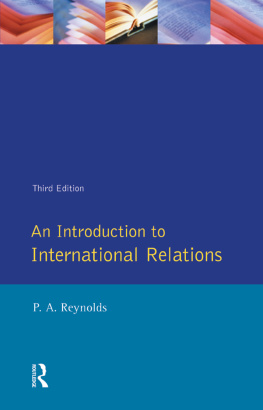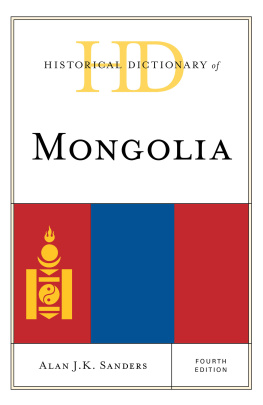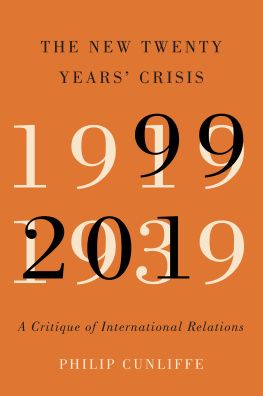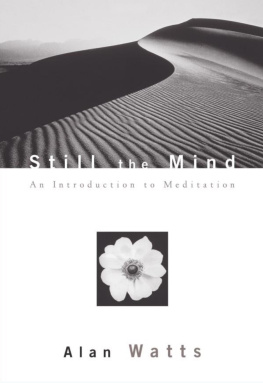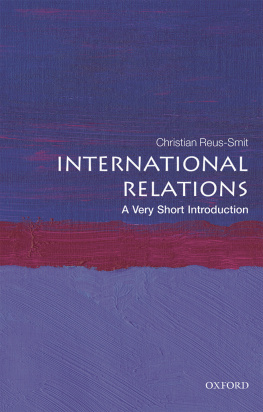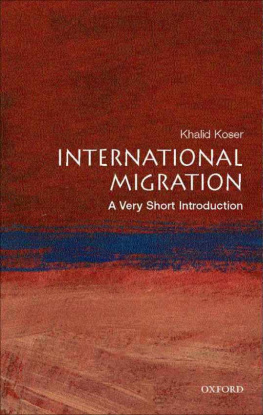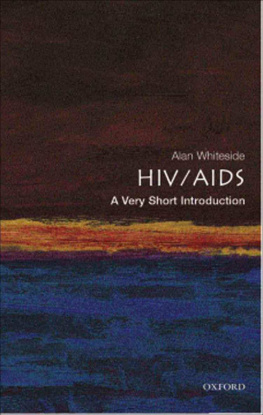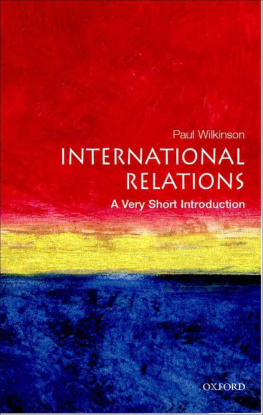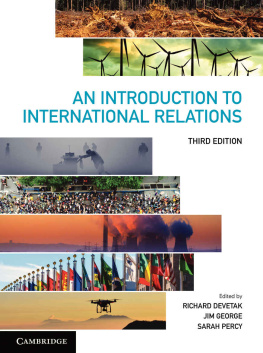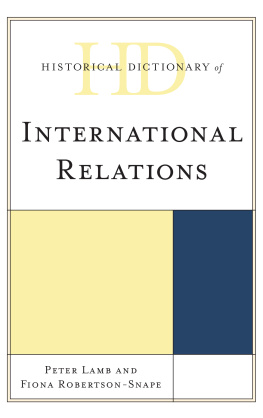AN INTRODUCTION TO INTERNATIONAL RELATIONS
An Introduction to International Relations
Third edition
P. A. REYNOLDS
FORMERLY PROFESSOR OF POLITICS, UNIVERSITY OF LANCASTER
First published 1971 by Pearson Education Limited
Second edition 1980
Third edition 1994
Published 2014 by Routledge
2 Park Square, Milton Park, Abingdon, Oxon OX14 4RN
711 Third Avenue, New York, NY 10017, USA
Routledge is an imprint of the Taylor & Francis Group, an informa business
Copyright 1971, 1980, 1994, Taylor & Francis.
All rights reserved. No part of this book may be reprinted or reproduced or utilised in any form or by any electronic, mechanical, or other means, now known or hereafter invented, including photocopying and recording, or in any information storage or retrieval system, without permission in writing from the publishers.
Notices
Knowledge and best practice in this field are constantly changing. As new research and experience broaden our understanding, changes in research methods, professional practices, or medical treatment may become necessary.
Practitioners and researchers must always rely on their own experience and knowledge in evaluating and using any information, methods, compounds, or experiments described herein. In using such information or methods they should be mindful of their own safety and the safety of others, including parties for whom they have a professional responsibility.
To the fullest extent of the law, neither the Publisher nor the authors, contributors, or editors, assume any liability for any injury and/or damage to persons or property as a matter of products liability, negligence or otherwise, or from any use or operation of any methods, products, instructions, or ideas contained in the material herein.
ISBN 978-0-582-21318-0 (pbk)
British Library Cataloguing-inPublication Data
A catalogue record for this book is available from the British Library
Library of Congress Cataloging-in-Publication Data
Reynolds, P. A. (Philip Alan), 1920
An introduction to international relations / P.A. Reynolds. -- 3rd ed.
p. cm.
Includes bibliographical references and index.
ISBN 0582213185
1. International relations. I. Title.
JX1395.R46 1994
327 -- dc20
932567
CIP
Contents
Until quite recently very few writers and scholars in the field of international relations had been trained in the subject as undergraduates. They began as historians or lawyers or economists or mathematicians or biologists, or perhaps as political scientists or sociologists. This is because the subject is quite new, the first chair having been founded in 1919, and effective development having begun only in the last twenty-five years. Consequently no methods of approaching the subject are universally accepted, and most teachers feel they want to set out their own way of looking at things.
Theories, models, methods of analysis have been pouring forth in the past fifteen years. The undergraduate lacks a guide through the jungle. This book does not pretend to provide a comprehensive guide. Its purpose is to elaborate some of the approaches which the author has found most helpful. The early chapters are concerned with states, what they are and how and why actions are taken on their behalf. This is one part perhaps the major part of what may be called micro-analysis. The later chapters offer an elementary introduction to some problems of macro-theory, using mainly the tools of systems analysis.
I should like to thank Professor Gwilym Jenkins, Martin Edmonds, and David Travers, all of the University of Lancaster, who read parts of the text or corrected me on points of detail. Discussions with students over the past ten years in Aberystwyth and Lancaster have greatly helped to clarify the ideas which are expressed in this book. The responsibility for what is written here is of course mine.
P.A.R.
Lancaster, 1970
As the first edition of this book was going to press two significant developments of theorizing in international relations were occurring. The first of these, in micro-international relations, was the application of organization theory to decision-making in international relations, most clearly expressed in the work of Graham T. Allison. The second reflected growing awareness of the extent to which the different parts of the world were getting mixed up together, and through such concepts as linkage politics and interdependence it called into question the validity of the distinction between comparative and international politics, and between micro- and macro-international relations. To take account of these developments has been added.
The opportunity has been taken to make throughout the book a number of small changes or revisions to improve clarity or to substitute more up to date illustrations of the argument.
The third edition of this book incorporates revisions of two kinds. In the first place, while the argument of remains largely unaltered, many of the illustrations have been updated. Particular note has been taken of recent changes in the role of the United Nations, of developments of the European Community, and of the profound effects of the collapse of the so-called communist regimes in the former Soviet Union and in eastern Europe.
Secondly, the fourth Part added in 1980 has been divided into two chapters, the second of these being extensively rewritten to reflect developments in theory in the past decade. In the writing of this new chapter I received invaluable assistance from Dr (now Professor) Richard Little, both with advice on research sources, and in vetting my first draft. I am of course responsible for any errors or infelicities that remain.
Knowledge is a unity. Total understanding of any aspect of existence is impossible without total understanding of all other aspects. So man cannot achieve more than partial understanding of anything, though this partial understanding may often be sufficient for all practical purposes of behaviour, decision and action. But even this partial understanding may be achieved only by breaking the universe of knowledge into pieces the size of which the human mind is able to comprehend and manipulate. The further the range of mankinds knowledge is extended, the more difficult it becomes for a single mind to be master of more than a diminishing segment of it. Hence the increasing fragmentation of knowledge in past decades, the emergence of ever more, and ever narrower, specialisms. Yet the expansion of knowledge has brought with it heightened awareness of the interrelatedness of the segments into which it is artificially divided. It is thus widely recognized that narrowing specialisms cause loss of opportunities for greater understanding.
A solution to this problem is as yet hard to conceive, although it may well come from the mechanical storing of facts and information on a gigantic scale, with virtually instant access as required, thus freeing the human mind to work on principles and hypotheses and their interrelationships. So far as international relations is concerned, the assembling of relevant information and data has not yet proceeded very far, although the size of the data bank that might eventually be needed is beginning to be perceived.
The purpose of the foregoing is to make the obvious point that any delimitation of a field of knowledge which is then called international relations involves the making of arbitrary divisions: by some not absurd definitions of international relations the whole of human behaviour would fall within its field; and since human behaviour is affected by the physical, chemical and biological conditions of its environment, an attempt fully to explain, and not simply to describe, international relations so defined would have to range over the totality of human knowledge.


